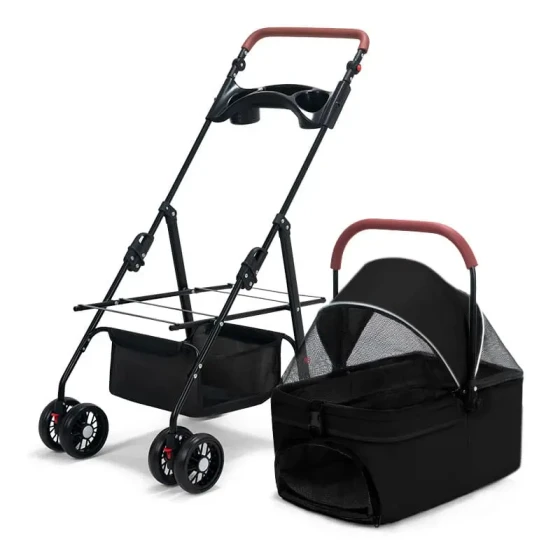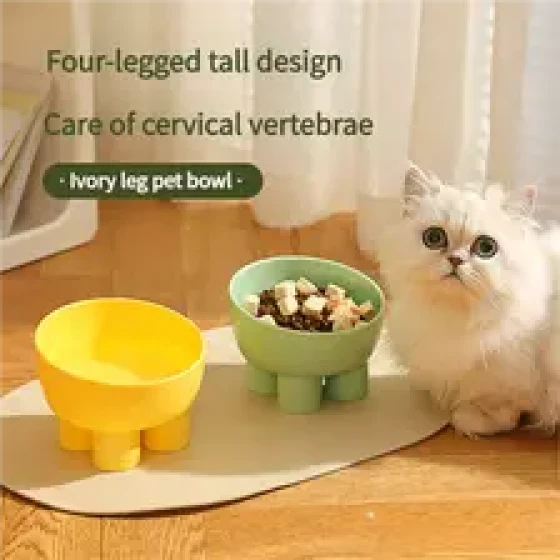Can Cats Eat Raw Beef_Risks and Precautions of Feeding Cats Raw Meat
Can Cats Eat Raw Beef? Risks and Precautions of Feeding Cats Raw Meat
Many cat owners may wonder, as our beloved cats are natural carnivores, whether it is suitable to feed them raw beef or, more broadly, if raw feeding is good or bad for them? In short, theoretically cats can eat raw beef and other raw meats because their digestive systems are made to process meat, but in reality raw feeding carries significant health risks, including bacterial and parasite infections as well as nutritional imbalances. Therefore, although some proponents believe raw feeding mimics the cat's natural diet, mainstream veterinarians and animal nutrition experts generally advise against exclusive raw feeding unless done under strict supervision and professional formulation.
Cats are obligate carnivores, which means their physiology and nutritional needs are built around a meat-based diet. In the wild, felines prey on small animals and directly consume their muscle, bones, and organs. This may make raw feeding seem logical, as if returning pet cats to their natural state. However, the household environment nowadays differs greatly from the wild, and meat produced for human consumption, although inspected to some degree during production, storage, and processing, may still carry pathogens harmful to cats' health.
Potential Benefits of Raw Feeding Cats (Supporters’ Views)
Some advocates of raw feeding believe it has various potential benefits for cats, including:
- Closer to natural diet: Imitates the cat’s wild hunting habits.
- Better hydration: Raw meat usually contains higher water content, helping cats supplement moisture (though encouraging drinking water remains very important).
- Improved oral health: Chewing on raw meaty bones (not all raw feeding includes bones) helps clean teeth (but also carries risk of bone damage).
- Healthier coat and skin: Some owners observe shinier fur and better skin condition after raw feeding (lacking large-scale scientific research support).
- Better digestion: Some cats may be intolerant to certain ingredients in processed cat foods; raw meat may be easier for them to digest (high individual variability).
It is important to emphasize that most of these “benefits” are based on individual observations and experience, lacking strong, peer-reviewed scientific support. When considering raw feeding, one must weigh these unproven potential benefits against the scientifically evidenced risks discussed below.
Potential Risks of Feeding Cats Raw Meat
This is a core issue to seriously consider when deciding on raw feeding. Raw feeding is not as simple as it sounds; it carries multiple, serious health risks, not only to cats but potentially to family members living together. As the saying goes, “illness enters through the mouth,” especially with raw meat.
- Bacterial contamination: This is one of the main risks. Raw meat, including seemingly fresh beef, may carry harmful bacteria such as Salmonella, Escherichia coli (E. coli), Listeria, and Campylobacter. These bacteria may cause cats to vomit, have diarrhea, lose appetite, or develop fever and other gastrointestinal symptoms; severe cases may be life-threatening. More dangerously, infected cats may be asymptomatic yet shed bacteria via feces, posing infection risks to household members, especially children, elderly, or immunocompromised individuals.
- Parasite infection: Raw meat may contain eggs or cysts of parasites like Toxoplasma gondii. While toxoplasmosis may have minimal clinical effects on cats, it can cause severe illness in humans (especially pregnant women and immunodeficient persons). Although deep freezing can kill some parasites to a degree, it is not effective against all types.
- Nutritional imbalance: Feeding only raw beef or other raw meats rarely meets all of a cat’s nutritional requirements. Cats need precise ratios of protein, fat, carbohydrates, vitamins, minerals—especially taurine. Taurine is an essential amino acid for cats; deficiency leads to severe health issues such as dilated cardiomyopathy, blindness, and even death. Raw meat alone typically lacks taurine, contains imbalanced calcium-to-phosphorus ratios, and is deficient in other vitamins and minerals. Long-term nutritional imbalance causes irreversible harm to cats’ health.
- Bone injury risk: If raw feeding includes bones, improperly handled bones (especially cooked or small, sharp bones) may puncture the cat’s mouth, esophagus, or gastrointestinal tract, causing bleeding, obstruction, or perforation requiring emergency surgery. Even raw bones need to be chosen and processed according to the cat’s size and bone type.
Based on these definite risks, the World Organisation for Animal Health (OIE), American Veterinary Medical Association (AVMA), and most national veterinary associations do not recommend pet owners to practice raw feeding at home on their own.
How to Reduce Risks of Raw Feeding (If You Choose to Do So)
Despite risks, if you decide to try raw feeding for various reasons, extremely strict precautions must be taken to lower the risks. It is strongly advised to proceed only under the guidance of a professional registered animal nutritionist or veterinarians experienced in raw feeding. This is not something to try casually.
- Choose high-quality meat sources: Prefer raw meaty bones specifically produced for pets, meeting strict hygiene standards, rather than raw meat purchased for human consumption from supermarkets. Human-grade meat standards differ from pet food, and cooking for humans kills pathogens, which raw feeding lacks.
- Strict hygiene practices: Handle raw meat as carefully as for human consumption. Use dedicated cutting boards, knives, and feeding bowls; wash hands, all surfaces, and utensils thoroughly with soap and hot water right after contact. Avoid cross-contamination of raw meat or saliva/feces from cats to other household items or food.
- Freezing at low temperatures: Freeze meat at -18°C (0°F) or below for at least three weeks (21 days) to kill most parasites. Note freezing does not kill all bacteria or viruses.
- Ensure nutritional balance: Never feed single-type raw meat only! A qualified raw diet formula needs to include muscle meat, organs (such as liver, heart), proper amounts of bone (ground or specific types), and essential vitamin/mineral supplements, especially taurine. Homemade raw meals almost never achieve nutritional balance and risk causing deficiencies. Consider buying reputable commercial raw meaty bone products and carefully check ingredient and nutrition labels.
- Regular check-ups and fecal exams: Take cats for regular veterinary exams and stool tests to detect parasite infections timely.
- Closely monitor cats’ health: Watch for vomiting, diarrhea, lethargy, or loss of appetite. If symptoms appear, seek veterinary care immediately and inform the vet about raw feeding.
Alternatives
Considering the risks and complexities of raw feeding, most veterinarians recommend safer, more reliable feeding methods:
- High-quality commercial cat food: Select complete balanced cat foods from reputable brands meeting AAFCO (Association of American Feed Control Officials) or regional pet food nutritional standards, including dry or wet food. These are scientifically formulated to provide cats all necessary nutrients.
- Homemade cat food (under professional guidance): If preparing home-cooked meals for cats, always do so under the precise guidance of a registered animal nutritionist. They will provide recipes based on the cat’s specific conditions (age, weight, health) and instruct on proper cooking and nutritional supplementation to ensure a balanced diet. Simple home-cooked meats (such as boiled chicken breast or beef) cannot serve as a complete diet because they lack all required nutrients.
FAQ
- Q: Will cats be healthier eating raw meat?
A: There is insufficient scientific evidence supporting this claim. Although some supporters say so, scientific data mostly focuses on the risks of raw feeding. - Q: Does freezing raw meat kill all bacteria?
A: No. Freezing kills most parasites but is limited against many bacteria such as Salmonella and E. coli. - Q: If I feed my cat raw meat, is there risk to humans?
A: Yes, risks are mutual. Bacteria and parasites on raw meat can spread to humans through food handling, cat saliva, or feces, causing foodborne illnesses. - Q: Is it safe to occasionally give my cat a little raw beef?
A: Even occasional feeding carries risks as raw meat can still harbor pathogens. For safety, raw meat feeding is not recommended casually. - Q: Are commercial raw meaty bone products safe?
A: Commercial products usually have better hygiene controls than homemade raw meat, and some apply bacterial reduction methods (like high-pressure processing). However, choose products with good reputation, proper nutritional standards, and clear labeling, and maintain hygiene during handling.
Conclusion
Although cats are carnivores, feeding raw meat in modern household settings poses significant health risks, including serious bacterial and parasite infections as well as nutritional imbalances. These risks threaten both cats and humans living with them. While some advocate raw feeding, its benefits are not yet scientifically validated, whereas the risks are clear.
Therefore, from health and safety perspectives, most veterinary professionals do not recommend pet owners to feed raw meat independently. If you consider changing your cat’s diet or are interested in raw feeding, the wisest and most responsible approach is to consult your veterinarian or a professional registered animal nutritionist. They can provide evidence-based advice to help you choose the safest and most nutritionally balanced feeding plan for your cat, whether you ultimately choose high-quality commercial cat food or professionally guided homemade meals. Your cat’s health comes first—do not expose them to unnecessary risks based on fleeting ideas.





-560x560.webp)